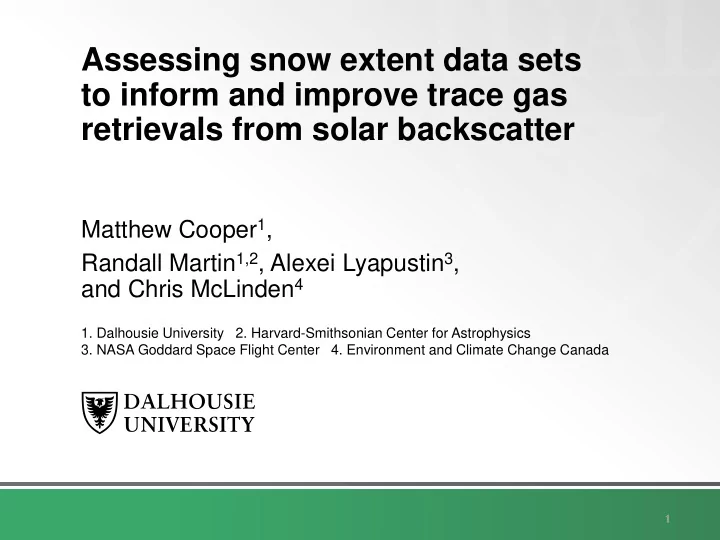

Assessing snow extent data sets to inform and improve trace gas retrievals from solar backscatter Matthew Cooper 1 , Randall Martin 1,2 , Alexei Lyapustin 3 , and Chris McLinden 4 1. Dalhousie University 2. Harvard-Smithsonian Center for Astrophysics 3. NASA Goddard Space Flight Center 4. Environment and Climate Change Canada 1 1
Snow cover is challenging to trace gas retrievals Retrieved VCD are sensitive to surface reflectance Snow cover varies with space and time Existing reflectivity climatologies don’t represent snow well Snow cover is often mistaken for cloud (and vice versa) Mistakes in snow attribution cause retrieved NO 2 column errors of 20-50% * * [O’Byrne et al., JGR 2010] 2
Snowy scenes often omitted due to potential errors Greatly reduces number of usable observations Photo credit: NASA/Goddard Space Flight Center Scientific Visualization Studio 3
Air Mass Factor: A Large Source of Uncertainty in Trace Gas Retrievals 𝐵𝑁𝐺 = 𝑝𝑐𝑡𝑓𝑠𝑤𝑓𝑒 𝑡𝑚𝑏𝑜𝑢 𝑑𝑝𝑚𝑣𝑛𝑜 𝑤𝑓𝑠𝑢𝑗𝑑𝑏𝑚 𝑑𝑝𝑚𝑣𝑛𝑜 𝑒𝑓𝑜𝑡𝑗𝑢𝑧 = 𝐵𝑁𝐺𝐻 න 𝑥 𝑨 𝑇 𝑨 𝑒𝑨 Radiative Transfer Model Atmospheric Chemistry Model Scattering Weights w(z) function of: NO 2 Shape Factor S(z) • Viewing geometry • Clouds, aerosols 𝑇 𝑨 = 𝑜(𝑨) • Surface reflectance Ω 𝑤 −1 𝛽(𝑨) 𝜖 ln 𝐽 𝐶 𝑥 𝑨 = 𝐵𝑁𝐺 𝐻 𝛽 𝑓 𝜖𝜐 4
Bright surfaces benefit retrieval sensitivity Reflect=0.07 Reflect=0.07 Reflect=0.83 Reflect=0.81 Solar θ =79° Solar θ =60° Sat. θ =60° Sat. θ =58° Scattering Weight = observed backscattered light sensitivity to NO 2 5
Bright surfaces benefit retrieval sensitivity AMF doubles over snow! Means better data quality. Good snow identification has potential to improve trace gas retrievals 6
Evaluation of Snow Extent Products Canadian IMS MODIS products Meteorological Multiple satellite VIS-IR radiances. On Centre (CMC) (Visible & microwave) Aqua and Terra Surface snow depth + ground data + satellites measurements models 0.05° Resolution 25 km resolution 4 km resolution MAIAC products NISE MODIS radiances Microwave (SSM/I) 1 km resolution 25 km resolution Compare against >15,000 ground stations from GHCN-D database 7
IMS best agrees with observations Accuracy Precision Recall F CMC 0.91 0.79 0.83 0.81 IMS 0.93 0.87 0.83 0.85 MAIAC Aqua 0.91 0.90 0.74 0.82 MAIAC Terra 0.91 0.90 0.75 0.82 MODIS Aqua 0.76 0.51 0.43 0.46 MODIS Terra 0.82 0.69 0.45 0.54 NISE 0.84 0.83 0.45 0.58 • Accuracy = P(data set is correct) • Tested at different resolutions • 4 km (shown here) • Precision = P(snow in data set is really there) • 25 km • Recall = P(finding snow when it is there) • Native resolutions • F = Balances Precision and Recall (best metric for evaluation) 8
IMS best agrees with observations Autumn F Winter F Spring F CMC 0.76 0.86 0.59 IMS 0.78 0.89 0.70 MAIAC Aqua 0.71 0.86 0.71 MAIAC Terra 0.71 0.86 0.71 MODIS Aqua 0.42 0.48 0.41 0.51 0.52 0.49 MODIS Terra 0.39 0.57 0.46 NISE • Performance of all data sets lower in melting, accumulation season 9
Spatial structure of IMS Evaluation • Most errors occur along Pacific coast, or in US South • Snow generally thinner and more transient, thus easier to miss 10
IMS well suited for informing TEMPO • Satellite-based product for informing satellite observations • Snow Depth ≠ Brightness from space • Multiple observations, different viewing geometries & times • Less cloud contamination 11
Improved data quantity AND quality by including snowy scenes • Simulated OMI observations of a GEOS-Chem simulation • Use IMS to identify snow cover • Use appropriate surface LER • Either omit or include snowy scenes 12
Improved data quantity AND quality by including snowy scenes • Including snowy scenes increases number of observations by factor of 2.1 (assuming clear skies) • Increases mean AMF x 2.7 in regions with occasional snow cover • Higher AMF = better data quality 13
Summary • Sensitivity to surface NO 2 increases over snow covered scenes • IMS is the best performing snow extent product over North America and is well suited for informing retrievals from TEMPO • Observation frequency and retrieval sensitivity increase by more than a factor of two by including observations over snow Conclusion Combining daily snow detection from IMS with a climatology of snow reflectance has the potential to greatly improve observation quantity and quality Cooper et al. (2018), Atm. Meas. Tech., 11, 1-12, doi:10.5194/amt-11-1-2018
Recommend
More recommend